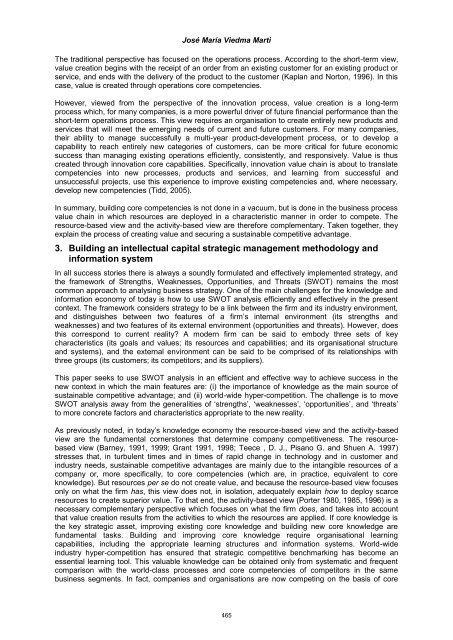Proceedings of the 3rd European Conference on Intellectual Capital
Proceedings of the 3rd European Conference on Intellectual Capital
Proceedings of the 3rd European Conference on Intellectual Capital
Create successful ePaper yourself
Turn your PDF publications into a flip-book with our unique Google optimized e-Paper software.
José María Viedma Marti<br />
The traditi<strong>on</strong>al perspective has focused <strong>on</strong> <str<strong>on</strong>g>the</str<strong>on</strong>g> operati<strong>on</strong>s process. According to <str<strong>on</strong>g>the</str<strong>on</strong>g> short-term view,<br />
value creati<strong>on</strong> begins with <str<strong>on</strong>g>the</str<strong>on</strong>g> receipt <str<strong>on</strong>g>of</str<strong>on</strong>g> an order from an existing customer for an existing product or<br />
service, and ends with <str<strong>on</strong>g>the</str<strong>on</strong>g> delivery <str<strong>on</strong>g>of</str<strong>on</strong>g> <str<strong>on</strong>g>the</str<strong>on</strong>g> product to <str<strong>on</strong>g>the</str<strong>on</strong>g> customer (Kaplan and Nort<strong>on</strong>, 1996). In this<br />
case, value is created through operati<strong>on</strong>s core competencies.<br />
However, viewed from <str<strong>on</strong>g>the</str<strong>on</strong>g> perspective <str<strong>on</strong>g>of</str<strong>on</strong>g> <str<strong>on</strong>g>the</str<strong>on</strong>g> innovati<strong>on</strong> process, value creati<strong>on</strong> is a l<strong>on</strong>g-term<br />
process which, for many companies, is a more powerful driver <str<strong>on</strong>g>of</str<strong>on</strong>g> future financial performance than <str<strong>on</strong>g>the</str<strong>on</strong>g><br />
short-term operati<strong>on</strong>s process. This view requires an organisati<strong>on</strong> to create entirely new products and<br />
services that will meet <str<strong>on</strong>g>the</str<strong>on</strong>g> emerging needs <str<strong>on</strong>g>of</str<strong>on</strong>g> current and future customers. For many companies,<br />
<str<strong>on</strong>g>the</str<strong>on</strong>g>ir ability to manage successfully a multi-year product-development process, or to develop a<br />
capability to reach entirely new categories <str<strong>on</strong>g>of</str<strong>on</strong>g> customers, can be more critical for future ec<strong>on</strong>omic<br />
success than managing existing operati<strong>on</strong>s efficiently, c<strong>on</strong>sistently, and resp<strong>on</strong>sively. Value is thus<br />
created through innovati<strong>on</strong> core capabilities. Specifically, innovati<strong>on</strong> value chain is about to translate<br />
competencies into new processes, products and services, and learning from successful and<br />
unsuccessful projects, use this experience to improve existing competencies and, where necessary,<br />
develop new competencies (Tidd, 2005).<br />
In summary, building core competencies is not d<strong>on</strong>e in a vacuum, but is d<strong>on</strong>e in <str<strong>on</strong>g>the</str<strong>on</strong>g> business process<br />
value chain in which resources are deployed in a characteristic manner in order to compete. The<br />
resource-based view and <str<strong>on</strong>g>the</str<strong>on</strong>g> activity-based view are <str<strong>on</strong>g>the</str<strong>on</strong>g>refore complementary. Taken toge<str<strong>on</strong>g>the</str<strong>on</strong>g>r, <str<strong>on</strong>g>the</str<strong>on</strong>g>y<br />
explain <str<strong>on</strong>g>the</str<strong>on</strong>g> process <str<strong>on</strong>g>of</str<strong>on</strong>g> creating value and securing a sustainable competitive advantage.<br />
3. Building an intellectual capital strategic management methodology and<br />
informati<strong>on</strong> system<br />
In all success stories <str<strong>on</strong>g>the</str<strong>on</strong>g>re is always a soundly formulated and effectively implemented strategy, and<br />
<str<strong>on</strong>g>the</str<strong>on</strong>g> framework <str<strong>on</strong>g>of</str<strong>on</strong>g> Strengths, Weaknesses, Opportunities, and Threats (SWOT) remains <str<strong>on</strong>g>the</str<strong>on</strong>g> most<br />
comm<strong>on</strong> approach to analysing business strategy. One <str<strong>on</strong>g>of</str<strong>on</strong>g> <str<strong>on</strong>g>the</str<strong>on</strong>g> main challenges for <str<strong>on</strong>g>the</str<strong>on</strong>g> knowledge and<br />
informati<strong>on</strong> ec<strong>on</strong>omy <str<strong>on</strong>g>of</str<strong>on</strong>g> today is how to use SWOT analysis efficiently and effectively in <str<strong>on</strong>g>the</str<strong>on</strong>g> present<br />
c<strong>on</strong>text. The framework c<strong>on</strong>siders strategy to be a link between <str<strong>on</strong>g>the</str<strong>on</strong>g> firm and its industry envir<strong>on</strong>ment,<br />
and distinguishes between two features <str<strong>on</strong>g>of</str<strong>on</strong>g> a firm‘s internal envir<strong>on</strong>ment (its strengths and<br />
weaknesses) and two features <str<strong>on</strong>g>of</str<strong>on</strong>g> its external envir<strong>on</strong>ment (opportunities and threats). However, does<br />
this corresp<strong>on</strong>d to current reality? A modern firm can be said to embody three sets <str<strong>on</strong>g>of</str<strong>on</strong>g> key<br />
characteristics (its goals and values; its resources and capabilities; and its organisati<strong>on</strong>al structure<br />
and systems), and <str<strong>on</strong>g>the</str<strong>on</strong>g> external envir<strong>on</strong>ment can be said to be comprised <str<strong>on</strong>g>of</str<strong>on</strong>g> its relati<strong>on</strong>ships with<br />
three groups (its customers; its competitors; and its suppliers).<br />
This paper seeks to use SWOT analysis in an efficient and effective way to achieve success in <str<strong>on</strong>g>the</str<strong>on</strong>g><br />
new c<strong>on</strong>text in which <str<strong>on</strong>g>the</str<strong>on</strong>g> main features are: (i) <str<strong>on</strong>g>the</str<strong>on</strong>g> importance <str<strong>on</strong>g>of</str<strong>on</strong>g> knowledge as <str<strong>on</strong>g>the</str<strong>on</strong>g> main source <str<strong>on</strong>g>of</str<strong>on</strong>g><br />
sustainable competitive advantage; and (ii) world-wide hyper-competiti<strong>on</strong>. The challenge is to move<br />
SWOT analysis away from <str<strong>on</strong>g>the</str<strong>on</strong>g> generalities <str<strong>on</strong>g>of</str<strong>on</strong>g> ‗strengths‘, ‗weaknesses‘, ‗opportunities‘, and ‗threats‘<br />
to more c<strong>on</strong>crete factors and characteristics appropriate to <str<strong>on</strong>g>the</str<strong>on</strong>g> new reality.<br />
As previously noted, in today‘s knowledge ec<strong>on</strong>omy <str<strong>on</strong>g>the</str<strong>on</strong>g> resource-based view and <str<strong>on</strong>g>the</str<strong>on</strong>g> activity-based<br />
view are <str<strong>on</strong>g>the</str<strong>on</strong>g> fundamental cornerst<strong>on</strong>es that determine company competitiveness. The resourcebased<br />
view (Barney, 1991, 1999; Grant 1991, 1998; Teece , D. J., Pisano G. and Shuen A. 1997)<br />
stresses that, in turbulent times and in times <str<strong>on</strong>g>of</str<strong>on</strong>g> rapid change in technology and in customer and<br />
industry needs, sustainable competitive advantages are mainly due to <str<strong>on</strong>g>the</str<strong>on</strong>g> intangible resources <str<strong>on</strong>g>of</str<strong>on</strong>g> a<br />
company or, more specifically, to core competencies (which are, in practice, equivalent to core<br />
knowledge). But resources per se do not create value, and because <str<strong>on</strong>g>the</str<strong>on</strong>g> resource-based view focuses<br />
<strong>on</strong>ly <strong>on</strong> what <str<strong>on</strong>g>the</str<strong>on</strong>g> firm has, this view does not, in isolati<strong>on</strong>, adequately explain how to deploy scarce<br />
resources to create superior value. To that end, <str<strong>on</strong>g>the</str<strong>on</strong>g> activity-based view (Porter 1980, 1985, 1996) is a<br />
necessary complementary perspective which focuses <strong>on</strong> what <str<strong>on</strong>g>the</str<strong>on</strong>g> firm does, and takes into account<br />
that value creati<strong>on</strong> results from <str<strong>on</strong>g>the</str<strong>on</strong>g> activities to which <str<strong>on</strong>g>the</str<strong>on</strong>g> resources are applied. If core knowledge is<br />
<str<strong>on</strong>g>the</str<strong>on</strong>g> key strategic asset, improving existing core knowledge and building new core knowledge are<br />
fundamental tasks. Building and improving core knowledge require organisati<strong>on</strong>al learning<br />
capabilities, including <str<strong>on</strong>g>the</str<strong>on</strong>g> appropriate learning structures and informati<strong>on</strong> systems. World-wide<br />
industry hyper-competiti<strong>on</strong> has ensured that strategic competitive benchmarking has become an<br />
essential learning tool. This valuable knowledge can be obtained <strong>on</strong>ly from systematic and frequent<br />
comparis<strong>on</strong> with <str<strong>on</strong>g>the</str<strong>on</strong>g> world-class processes and core competencies <str<strong>on</strong>g>of</str<strong>on</strong>g> competitors in <str<strong>on</strong>g>the</str<strong>on</strong>g> same<br />
business segments. In fact, companies and organisati<strong>on</strong>s are now competing <strong>on</strong> <str<strong>on</strong>g>the</str<strong>on</strong>g> basis <str<strong>on</strong>g>of</str<strong>on</strong>g> core<br />
465
















